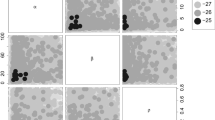Abstract
It is valuable in earthquake prediction to determine the occurrence probability of major earthquakes by making use of data obtained from precursory phenomena up to the time of the evaluation. In this study, the time evolution of the state determined by earthquakes and precursory phenomena was modelled using Markov chains. Various probabilities suitable for earthquake prediction were derived from the transition probability of the Markov chain with a chosen length of memory time. As an example, earthquake sequence records for northern China, which covered a period of about two thousand years, were examined and the results were also obtained from modern scientific observations of the radon anomaly which covered a period of about 10 years.
Assuming moderate-sized earthquakes of two magnitude ranges 4 3/4 ≤ M ≤ 5 3/4, 6 ≤ M ≤ 6 3/4 as precursors to large earthquakes of a magnitude range, 7 ≤ M ≤ 8 1/2, transition probabilities were calculated for a time interval from 2 to 40 yr. The results showed that the precursory time of moderate-sized earthquakes is mainly distributed in a time span of around several years and that the earthquake occurrence probability is considerably large when the precursory earthquakes occur successively. Furthermore, it was shown that a larger moderate-sized earthquake (4 3/4 ≤ M ≤ 5 3/4) is a more effective precursor than an entire moderate-sized earthquake (4 3/4 ≤ M ≤ 6 3/4).
Second, a multiple precursor case was tried by means of simulation based on the radon anomaly data obtained during a limited observation period. Simultaneous occurrence of two precursors makes the earthquake occurrence probability increase by 1.5–2.0 for a reasonable choice of a mean recurrence interval of the radon anomaly compared with the case where only a moderate-sized earthquake was treated as the precursor. However, the probability is much the same if the average recurrence interval of the radon anomaly is the same through time, including the preparatory period before the earthquake.
Similar content being viewed by others
References
Akaike, H.: 1974, A new look at the statistical model identification, IEEE Trans. Automat. Control AC-19, 716–723.
Aki, K.: 1981, A probabilistic synthesis of precursory phenomena, in D. W. Simpson and P. G. Richards, (eds) Earthquake Prediction: An International Review, Maurice Ewing Series, Vol. 4, AGU, Washington, D.C., pp. 566–574.
Anderson, J. G.: 1982, Revised estimates for the probabilities of earthquakes following observation of unreliable precursors, Bull. Seismol. Soc. Amer. 72, 879–888.
Ashok, S. P., Kulkarmi, R. B., and Tocher, D.: 1980, A semi-Markov model for characterizing recurrence of great earthquakes, Bull. Seismol. Soc. Amer. 70, 323–347.
Cao, T. and Aki, K.: 1983, Assigning probability gain for precursors of four large Chinese earthquakes, J. Geophys. Res. 88, 2185–2190.
Chen, Z.: 1986, Earthquake prediction research in China: status and prospects, J. Phys. Earth 34, Suppl., S1-S11.
Feller, W.: 1968, An Introduction to Probability Theory and Its Applications, Vol. 1, John Wiley, New York.
Habermann, R. E.: 1982, Consistency of teleseismic reporting since 1963, Bull. Seismol. Soc. Amer. 72, 93–111.
Hagiwara, Y.: 1974, Probability of earthquake occurrence as obtained from a Weibull distribution analysis of crustal strain, Tectonophysics 23, 313–318.
Hagiwara, Y.: 1975, A stochastic model of earthquake occurrence and the accompanying horizontal land deformations. Tectonophysics 26, 91–101.
Hamada, K.: 1983, A probability model for earthquake prediction, Earthquake Prediction Res. 2, 227–234.
Imoto, M. and Ishiguro, M.: 1986, A Bayesian approach to the detection of changes in the magnitude-frequency relation of earthquakes, J. Phys. Earth. 34, 441–455.
Kanamori, H.: 1981, The nature of seismicity patterns before large earthquakes. in D. W. Simpson and P. G. Richards (eds), Earthquake Prediction: An International Review, Maurice Ewing Series, Vol. 4, AGU, Washington, D.C., pp. 1–19.
Matsumura, S.: 1984, A one-dimensional expression of seismicity patterns in space and time, Bull. Seismol. Soc. Amer. 74, 2559–2576.
Ogata, Y.: 1983, Estimation of the parameters in the modified Omori formula for aftershock frequencies by the maximum likelihood procedure, Phys. Earth 31, 115–124.
Ogata, Y.: 1988, Statistical models for earthquake occurrences and residual analysis for point processes, J. Amer. Statistical Assoc. 83, No. 401, Application, 9–27.
Rikitake, T.: 1969, Prediction of magnitude and occurrence time of earthquakes, Bull. Earthquake Res. Inst. 47, 107–128.
Rikitake, T.: 1976, Earthquake Prediction, Elsevier, New York.
Utsu, T.: 1982, Probabilities in earthquake prediction (The second paper), Bull. Earthquake Res. Inst. 57, 499–524.
Utsu, T.: 1983, Probabilities associated with earthquake prediction and their relationships, Earthquake Prediction Res. 2, 105–114.
Vere-Jones, D.: 1970, Stochastic models for earthquake occurrence (with discussion), J. Roy. Statist. Soc. Ser. B 32, 1–62.
Vere-Jones, D.: 1978, Earthquake prediction — A statistician's view, J. Phys. Earth 26, 129–146.
Author information
Authors and Affiliations
Rights and permissions
About this article
Cite this article
Fujinawa, Y. A method for estimating earthquake occurrence probability using first- and multiple-order Markov chain models. Nat Hazards 4, 7–22 (1991). https://doi.org/10.1007/BF00126556
Received:
Accepted:
Issue Date:
DOI: https://doi.org/10.1007/BF00126556




